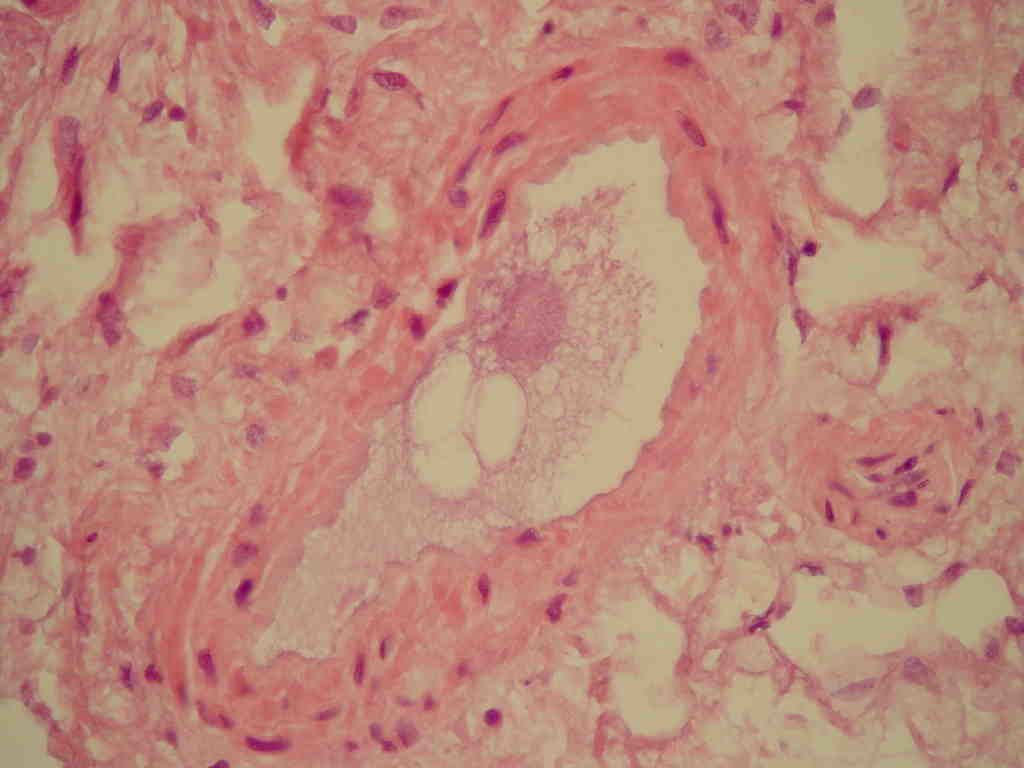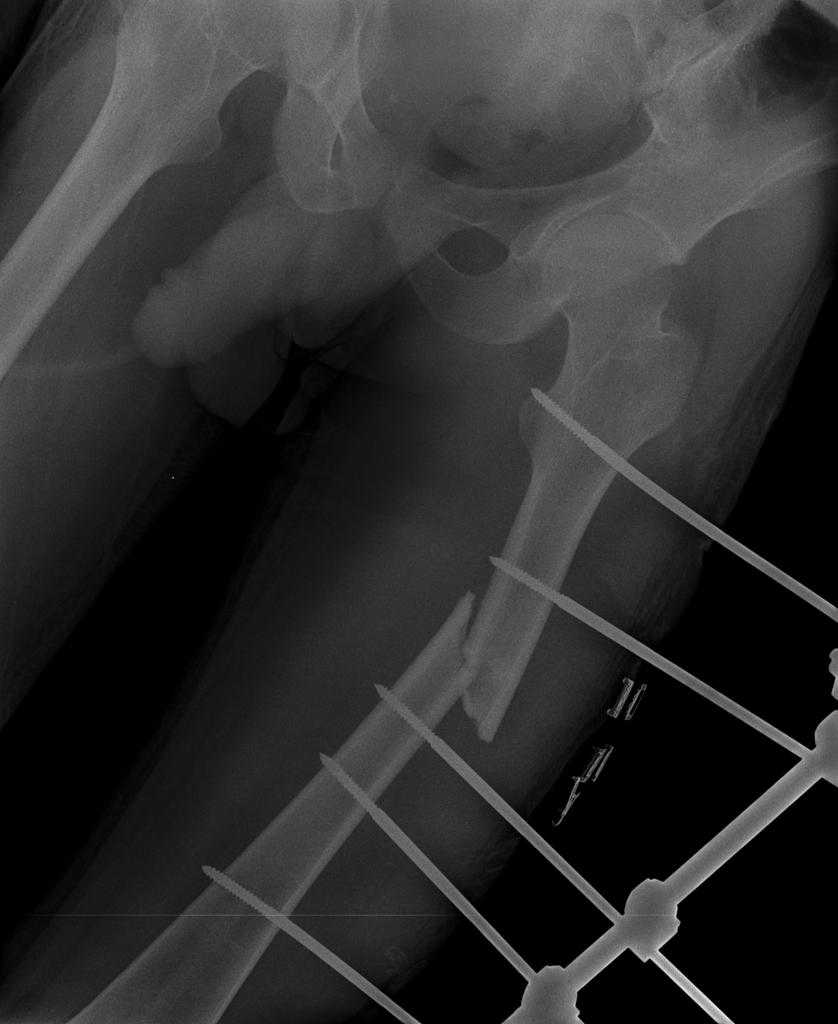Fat embolism syndrome pathophysiology
|
Fat embolism syndrome Microchapters |
|
Diagnosis |
|---|
|
Treatment |
|
Case Studies |
|
Fat embolism syndrome pathophysiology On the Web |
|
American Roentgen Ray Society Images of Fat embolism syndrome pathophysiology |
|
Risk calculators and risk factors for Fat embolism syndrome pathophysiology |
Editor-In-Chief: C. Michael Gibson, M.S., M.D. [1] Associate Editor(s)-in-Chief: Feham Tariq, MD [2]
Overview
Fat embolism syndrome (FES) is the presence of fat globules in the circulation post traumatic insult which can lodge into the small sized capillaries in the lung, brain and skin leading to devastating clinical manifestations. The two widely accepted theories which explain the pathophysiology of FES are mechanical and biochemical theory. The mechanical theory proposes that there is mechanical obstruction by fat cells from the bone marrow in the end-capillaries after trauma. Biochemical theory attributes the clinical manifestations of FES to the pro inflammatory effect of fat emboli.
Pathophysiology
Two major theories have been described to explain the pathophysiology of fat embolism syndrome(FES):[1][2]
- Mechanical theory
- Biochemical theory
Mechanical theory
The theory proposes that there is mechanical obstruction by fat cells from the bone marrow in the end-capillaries after trauma.
- Post traumatic insult, the fat cells travel via venous sinusoids to the capillaries.
- These cells have potent prothrombotic and proinflammatory potential.
- They trigger rapid aggregation of platelets and accelerated fibrin generation as they travel through the venous system, eventually lodging in the pulmonary arterial circulation.
- Pulmonary capillary obstruction leads to interstitial hemorrhage and edema, alveolar collapse, and reactive hypoxemic vasoconstriction.
- Massive fat emboli may also lead to macrovascular obstruction and shock.
- Fat cells may also enter the arterial circulation via a patent foramen ovale or directly through the pulmonary capillary bed, causing the characteristic neurological and dermatologic findings of FES.
Biochemical theory
This theory attributes the clinical manifestations of FES to the pro inflammatory effect of fat emboli.[3][4][5]
- Tissue lipases break down the fat in the bone marrow, forming high levels of the following toxic intermediaries:[6][7]
- Free fatty acids:
Free fatty acids are released into the circulation after hydrolysis and deposit into the end capillaries of the lung, manifesting as acute respiratory distress syndrome.[8][9]
- Cytokines:
Patients with FES are also found to have high levels of certain cytokines such as tumor necrosis factor alpha, phospholipase A2, interleukin 1 and 6.[10][11]
- C-reactive proteins:
The elevation in c-reactive proteins is responsible for lipid agglutintion in FES which results in microvasculature obstruction and stagnant blood flow.
- Eventually, these intermediate products lead to end-organ dysfunction.
- In the lung, toxic injury to pneumocytes and pulmonary endothelial cells causes vasogenic and cytotoxic edema as well as hemorrhage.
- Acute lung injury or acute respiratory distress syndrome results from damaged pulmonary endothelium that triggers a proinflammatory cytokine cascade.
Pathogenesis of clinical manifestations
Following pathological sequence of events occur after an orthopedic trauma such as long bone fracture.
| Microvascular obstruction and free fatty acids(FFA) mediated endothelial injury leading to proinflammatory cytokine release(IL-1,IL-6,TNF-alpha) | Acute respiratory distress syndrome | ||||||||||||||||||||||||
| Arterial hypoxemia and cerebral vascular injury from FFA intermediates | Encephalopathy and focal neurological deficits | ||||||||||||||||||||||||
| Vascular stasis,microinfarction and FFA mediated endothelial damage leading to rupture of thin-walled capillaries | Petechiae | ||||||||||||||||||||||||
| Elevated tissue factor, excess thrombin and fibrin generation, aggregation of platelets and consumption of coagulation products | DIC, thrombocytopenia and anemia | ||||||||||||||||||||||||
Video
{{#ev:youtube|eeAQ2akVjL8}}
Genetics
- There is no genetic association of FES.
Gross pathology
There is no characteristic gross pathology associated with fat embolism.
Microscopic pathology
Hematoxylin and eosin staining shows the following changes in the lungs, kidneys and brain:[12]
Lung:
- Alveolar haemorrhagic edema
- Fat droplet deposition
- Fibrin thrombi
- Multiple fat droplets
Immunohistochemical staining shows the following changes:
- Raised levels of iNOS in the alveolar macrophages.
Kidney:
- Hematoxylin and eosin staining shows fat deposits in the glomeruli.
Brain:
- Fat droplets are seen in vessels.

Gallery

References
- ↑ Parisi DM, Koval K, Egol K (2002). "Fat embolism syndrome". Am J Orthop (Belle Mead NJ). 31 (9): 507–12. PMID 12650535.
- ↑ Robert JH, Hoffmeyer P, Broquet PE, Cerutti P, Vasey H (1993). "Fat embolism syndrome". Orthop Rev. 22 (5): 567–71. PMID 8316420.
- ↑ Husebye EE, Lyberg T, Røise O (2006). "Bone marrow fat in the circulation: clinical entities and pathophysiological mechanisms". Injury. 37 Suppl 4: S8–18. doi:10.1016/j.injury.2006.08.036. PMID 16990064.
- ↑ Estèbe JP (1997). "[From fat emboli to fat embolism syndrome]". Ann Fr Anesth Reanim. 16 (2): 138–51. PMID 9686075.
- ↑ Hofmann S, Huemer G, Kratochwill C, Koller-Strametz J, Hopf R, Schlag G; et al. (1995). "[Pathophysiology of fat embolisms in orthopedics and traumatology]". Orthopade. 24 (2): 84–93. PMID 7753543.
- ↑ Nixon JR, Brock-Utne JG (1978). "Free fatty acid and arterial oxygen changes following major injury: a correlation between hypoxemia and increased free fatty acid levels". J Trauma. 18 (1): 23–6. PMID 621762.
- ↑ Baker PL, Pazell JA, Peltier LF (1971). "Free fatty acids, catecholamines, and arterial hypoxia in patients with fat embolism". J Trauma. 11 (12): 1026–30. PMID 4330876.
- ↑ Schnaid E, Lamprey JM, Viljoen MJ, Joffe BI, Seftel HC (1987). "The early biochemical and hormonal profile of patients with long bone fractures at risk of fat embolism syndrome". J Trauma. 27 (3): 309–11. PMID 3560274.
- ↑ Meininger G, Hadigan C, Laposata M, Brown J, Rabe J, Louca J; et al. (2002). "Elevated concentrations of free fatty acids are associated with increased insulin response to standard glucose challenge in human immunodeficiency virus-infected subjects with fat redistribution". Metabolism. 51 (2): 260–6. PMID 11833059.
- ↑ Kao SJ, Yeh DY, Chen HI (2007). "Clinical and pathological features of fat embolism with acute respiratory distress syndrome". Clin Sci (Lond). 113 (6): 279–85. doi:10.1042/CS20070011. PMID 17428199.
- ↑ Prakash S, Sen RK, Tripathy SK, Sen IM, Sharma RR, Sharma S (2013). "Role of interleukin-6 as an early marker of fat embolism syndrome: a clinical study". Clin Orthop Relat Res. 471 (7): 2340–6. doi:10.1007/s11999-013-2869-y. PMC 3676609. PMID 23423626.
- ↑ . doi:10.1042/CS2007001. Missing or empty
|title=(help)